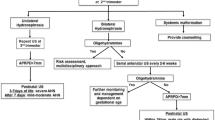Abstract
The incidence of asymptomatic hydronephrosis in newborns is high. Despite extensive clinical and scientific research much controversy still exists about the assessment and management of hydronephrosis during infancy. Postnatal management demands a detailed prenatal history. Initial workup in newborns with unilateral hydronephrosis starts with a physical examination and sonography of the urinary tract on day 3–5. Grades 3 and 4 hydronephrosis are further investigated with a voiding cystourethrogram (VCUG) and diuretic renogram between weeks 4 and 6. An infant with an asymptomatic unilateral hydronephrosis of any grade, without urinary infection and stable washout, and stable normal differential function on serial controls can be managed conservatively. The goal of all therapeutic strategies in the management of newborn hydronephrosis is to select all infants with severe obstructive dilatation during serial follow-ups and to perform surgical repair before irreversible deterioration and functional renal damage occurs. Interdisciplinary cooperation between experienced pediatric urologists, nephrologist and radiologists is the basis for optimal decision making.

Similar content being viewed by others
References
Avni FE, Bali MA, Regnault M, Damry M, Degroot F, Metens TH, Matos C (2002) MR urography in children. Eur J Radiol :154–166
Beetz R, Bökenkamp A, Brandis M, Hoyer P, John U, Rascher W (2001) Diagnostik bei konatalen Dilatationen der Harnwege. Urologe A 40:495–509
Dhillon H (1995) Imaging and follow up of neonatal hydronephroses. Curr Opin Urol 5:75–78
Dhillon H (1998) Prenataly diagnosed hydronephrosis: the Great Ormond Street experience. Br J Urol 81 [Suppl 2]:39–44
Dremsek PA, Gindl K, Voitl P (1997) Renal pyelectasis in fetuses and neonates: diagnostic value of renal pelvis diameter in pre- and postnatal sonographic sreening. Am J Roentgenol 168:1017–1019
Dudley JA, Haworth JM, McGraw ME, Frank JD, Tizard EJ (1997) Clinical relevance and implications of antenatal hydronephrosis. Arch Dis Child Fetal Neonatal Ed 76:31–34
Kass EJ, Majd M, Belmann AB (1985) Comparison of the diuretic renogram and the pressure perfusion study in children. J Urol 134:92–96
Koff S, Campbell K (1994) The nonoperative management of unilateral neonatal hydonephrosis: natural history of poorly functioning kidneys. J Urol 152:593–595
Maizels M, Reismann ME, Flom LS, Nelson J, Fernbach S, Firlit CF, Conway CC (1992) Nephroureteral dilatation detected in the first year of life: correlation with obstruction. J Urol 148:609–614
O’Reilly PH, Testa HJ, Lawson RS, Farrer DJ, Edwards EC (1978) Diuresis renography in equivocal urinary tract obstruction. Br J Urol 64:125–129
Oswald J, Riccabona M, Lusuardi L, Ulmer H, Bartsch G, Radmayr C (2002) Voiding cystourethrography using the suprapubic versus transurethral route in infants and children: results of a prospective pain scale oriented study. J Urol 168:2586–2589
Peters C. Urinary tract obstruction in children. J Urol 1995; 154, 1874–1884
Ransley P, Dhillon H, Gordon I, Duffy P, Dillon M, Barrat T (1990) The postnatal management of hydronephroses diagnosed by prenatal ultrasound. J Urol 144:584–587
Riccabona M, Lindbichler F, Sinzig M (2002) Conventional imaging in paediatric uroradiology. Eur J Radiol 43:100–109
Rosi P, Virgili G, Distasi SM (1990) Diuretic ultrasound a noninvasive technique for the assessment of upper tract obstruction. Br J Urol 65:566–569
Shokeir AA (1999) The diagnosis of upper urinary tract obstruction. BJU Int 83:893–901
Upsdell SM, Testa MJ, Lawson RS (1992) The F-15 diuresis renogram in suspected obstruction of the upper urinary tract. Br J Urol 69:126–131
Woodward M, Frank D (2002) Postnatal management of antenatal hydronephrosis. BJU Int 89:149–156
Yerkes EB, Adams M, Pope JC, Brock JW (1999) Does every patient with prenatal hydronephrosis need voiding cystogram? J Urol 162:1218–1220
Zerin JM, Ritchey ML, Chang AC (1993) Incidental vesicoureteral reflux in neonates with antenatally detected hydronephrosis and other renal abnormalities. Radiology 187:157–160
Author information
Authors and Affiliations
Corresponding author
Rights and permissions
About this article
Cite this article
Riccabona, M. Assessment and management of newborn hydronephrosis. World J Urol 22, 73–78 (2004). https://doi.org/10.1007/s00345-004-0405-0
Received:
Accepted:
Published:
Issue Date:
DOI: https://doi.org/10.1007/s00345-004-0405-0




